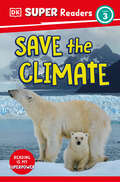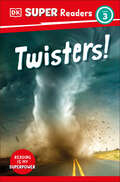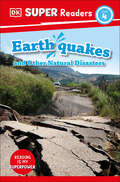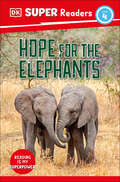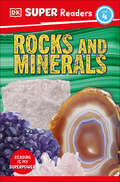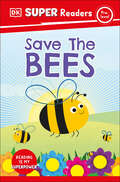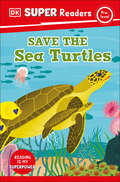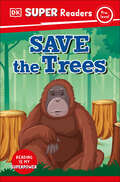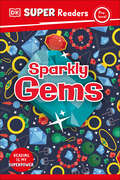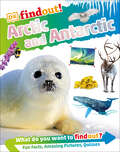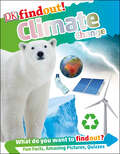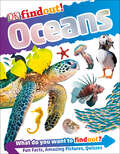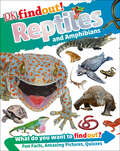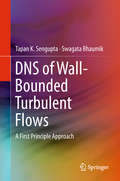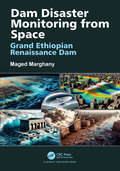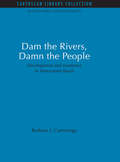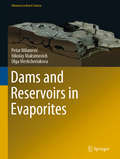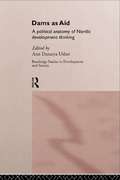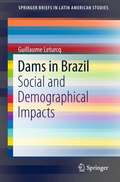- Table View
- List View
DK Super Readers Level 3 Save the Climate (DK Super Readers)
by DKYou can help save the climate! Make reading your superpower with DK&’s beautiful, levelled non-fiction.Use your reading superpowers to learn all about climate change, and what you can do to help save the climate - a high-quality, fun, non-fiction reader - carefully levelled to help children progress.Save the Climate is a beautifully designed reader all about the causes and effects of climate change, and what everyone can do to help.The engaging text has been carefully levelled using Lexile so that children are set up to succeed. A motivating introduction to using essential non-fiction reading skills. Children will love to find out about why global warming happens, what it means for our climate, and what they can each do to help save the climate.
DK Super Readers Level 3 Twisters! (DK Super Readers)
by DKHelp your child power up their reading skills and learn all about wild weather with this engaging nonfiction reader carefully leveled to help children progress.DK Super Readers Level 3: Twisters! will introduce kids to everything they need to know about twisters–from the scientists who track them to the people who have their lives turned upside down by the swirling winds–and is a motivating introduction to using essential nonfiction reading skills, proving ideal for children ready to enter the riveting world of reading. DK Super Readers take children on a journey through the wonderful world of nonfiction: traveling back to the time of dinosaurs, learning more about animals, exploring natural wonders and more, all while developing vital nonfiction reading skills and progressing from first words to reading confidently. The DK Super Readers series can help your child practice reading by:- Covering engaging, motivating, curriculum-aligned topics.- Building knowledge while progressing key Grades 3 and 4 reading skills.- Developing subject vocabulary on topics such as storms, twisters, and extreme weather.- Boosting understanding and retention through comprehension quizzes. Each title, which has been leveled using MetaMetrics®: The Lexile Framework for Reading, integrates science, geography, history, and nature topics so there&’s something for all children&’s interests. The books and online content perfectly supplement core literacy programs and are mapped to the Common Core Standards. Children will love powering up their nonfiction reading skills and becoming reading heroes. DK Super Readers Level 3 titles are visually engaging, full of fun facts about exciting topics, and motivate children to improve their nonfiction reading skills. Perfect for children ages 8 to 10 (Grades 3 and 4) who are newly independent readers ready to advance.
DK Super Readers Level 4 Earthquakes and Other Natural Disasters (DK Super Readers)
by DKDiscover the power of nature unleashed! Make reading your superpower with DK&’s beautiful, levelled non-fiction.Use your reading superpowers to learn all about a world of incredible natural disasters through history - a high-quality, fun, non-fiction reader - carefully levelled to help children progress. Earthquakes and Other Natural Disasters is a beautifully designed reader all about what happens when nature runs wild - from deadly volcanoes and shocking earthquakes, to floods, hurricanes, avalanches, and fires.The engaging text has been carefully levelled using Lexile so that children are set up to succeed. A motivating introduction to using essential non-fiction reading skills. Children will love to find out about dramatic natural disasters through history.
DK Super Readers Level 4 Hope for the Elephants (DK Super Readers)
by DKHelp your child power up their reading skills and learn all about one of the world&’s favorite animals, the elephant, with this fun-filled nonfiction reader carefully leveled to help children progress.DK Super Readers Level 4: Hope for the Elephants follows a young volunteer&’s time with elephants in India and Africa and introduces kids to everything they need to know about these much-loved animals–including where they live, why they are endangered, and what we can all do to help them–and is a motivating introduction to using essential nonfiction reading skills, proving ideal for children ready to enter the riveting world of reading. DK Super Readers take children on a journey through the wonderful world of nonfiction: traveling back to the time of dinosaurs, learning more about animals, exploring natural wonders and more, all while developing vital nonfiction reading skills and progressing from first words to reading confidently. The DK Super Readers series can help your child practice reading by:- Covering engaging, motivating, curriculum-aligned topics.- Building knowledge while progressing key Grades 4 and 5 reading skills.- Developing subject vocabulary on topics such as elephants, volunteering, and endangered animals.- Boosting understanding and retention through comprehension quizzes.Each title, which has been leveled using MetaMetrics®: The Lexile Framework for Reading, integrates science, geography, history, and nature topics so there&’s something for all children&’s interests. The books and online content perfectly supplement core literacy programs and are mapped to the Common Core Standards. Children will love powering up their nonfiction reading skills and becoming reading heroes. DK Super Readers Level 4 titles are visually engaging, full of fun facts, and challenge young readers to broaden their subject knowledge while practising nonfiction reading skills. Perfect for children ages 9 to 11 (Grades 4 and 5) who are confident readers ready for a challenge.
DK Super Readers Level 4 Rocks and Minerals (DK Super Readers)
by DKHelp your child power up their reading skills and learn all about Earth&’s geology with this fun-filled nonfiction reader carefully leveled to help children progress.DK Super Readers Level 4: Rocks and Minerals will introduce kids to everything they need to know about Earth&’s rocks and minerals—including fun facts about different rocks and minerals, how they form, and their properties and uses—and is a motivating introduction to using essential nonfiction reading skills, proving ideal for children ready to enter the riveting world of reading. DK Super Readers take children on a journey through the wonderful world of nonfiction: traveling back to the time of dinosaurs, learning more about animals, exploring natural wonders and more, all while developing vital nonfiction reading skills and progressing from first words to reading confidently. The DK Super Readers series can help your child practice reading by:- Covering engaging, motivating, curriculum-aligned topics.- Building knowledge while progressing key Grades 4 and 5 reading skills.- Developing subject vocabulary on topics such as geology, natural resources, and life on Earth.- Boosting understanding and retention through comprehension quizzes.Each title, which has been leveled using MetaMetrics®: The Lexile Framework for Reading, integrates science, geography, history, and nature topics so there&’s something for all children&’s interests. The books and online content perfectly supplement core literacy programs and are mapped to the Common Core Standards. Children will love powering up their nonfiction reading skills and becoming reading heroes. DK Super Readers Level 4 titles are visually engaging, full of fun facts, and challenge young readers to broaden their subject knowledge while practising nonfiction reading skills. Perfect for children ages 9 to 11 (Grades 4 and 5) who are confident readers ready for a challenge.
DK Super Readers Pre-Level Save the Bees (DK Super Readers)
by DKWhat&’s the buzz about bees? Make reading your superpower with DK&’s beautiful, leveled nonfiction.Use your reading superpowers to learn all about bees and why we need them - a high-quality, fun, nonfiction reader - carefully leveled to help children progress.Save the Bees is a beautifully designed reader all about bees - how they pollinate plants and make honey, and how we should look after them. The engaging text has been carefully leveled using Lexile so that children are set up to succeed. A motivating introduction to using essential nonfiction reading skills. Children will love to find out about different bees, the essential work they do for our planet, and the ways we can protect them.
DK Super Readers Pre-Level Save the Sea Turtles (DK Super Readers)
by DKSea turtles big and small need your help! Make reading your superpower with DK&’s beautiful, leveled nonfiction.Use your reading superpowers to learn all about different kinds of sea turtles and how you can help to keep them safe - a high-quality, fun, nonfiction reader - carefully leveled to help children progress.Save the Sea Turtles is a beautifully designed reader all about different kinds of sea turtles, from the smallest to the biggest, and how we can all help to keep their marine environment clean and safe. The engaging text has been carefully leveled using Lexile so that children are set up to succeed. A motivating introduction to using essential nonfiction reading skills. Children will love to find out about tiny turtles and the biggest turtles and their lives at sea.
DK Super Readers Pre-Level Save the Trees (DK Super Readers)
by DKLook after our world and save the trees! Make reading your superpower with DK&’s beautiful, leveled nonfiction.Use your reading superpowers to learn all about why we need trees and how you can plant, grow and save them - a high-quality, fun, nonfiction reader - carefully leveled to help children progress.Save the Trees is a beautifully designed reader all about why we need trees - to keep our air clean, provide shade, food, and homes for animals - and how we can grow and protect trees. The engaging text has been carefully leveled using Lexile so that children are set up to succeed. A motivating introduction to using essential nonfiction reading skills. Children will love to find out about the different ways trees support our lives - and how we can protect theirs.
DK Super Readers Pre-Level Seasons (DK Super Readers)
by DKHelp your child power up their reading skills and learn all about the four seasons with this fun-filled nonfiction reader carefully leveled to help children progress.DK Super Readers Pre-Level: Seasons will introduce kids to each season in turn—including fun facts about the weather, the wildlife, and the activities within each—and is a motivating introduction to using essential nonfiction reading skills, proving ideal for children ready to enter the riveting world of reading. DK Super Readers take children on a journey through the wonderful world of nonfiction: traveling back to the time of dinosaurs, learning more about animals, exploring natural wonders and more, all while developing vital nonfiction reading skills and progressing from first words to reading confidently. The DK Super Readers series can help your child practice reading by:- Covering engaging, motivating, curriculum-aligned topics.- Building knowledge while progressing key Grades Pre-K and K reading skills.- Developing subject vocabulary on topics such as seasons, weather, and nature.- Boosting understanding and retention through comprehension quizzes.Each title, which has been leveled using MetaMetrics®: The Lexile Framework for Reading, integrates science, geography, history, and nature topics so there&’s something for all children&’s interests. The books and online content perfectly supplement core literacy programs and are mapped to the Common Core Standards. Children will love powering up their nonfiction reading skills and becoming reading heroes. DK Super Readers Pre-level titles are visually engaging, full of fun facts, and introduce children to the wonderful world of nonfiction. Perfect to help children ages 3 to 5 (Grades Pre-K and K) who are ready to enter the world of reading.
DK Super Readers Pre-Level Sparkly Gems (DK Super Readers)
by DKHelp your child power up their reading skills and learn all about beautiful gems with this fun-filled nonfiction reader carefully leveled to help children progress.DK Super Readers Pre-Level: Sparkly Gems will introduce kids to a parade of gems—including rubies, emeralds, pearls, and diamonds—and is a motivating introduction to using essential nonfiction reading skills, proving ideal for children ready to enter the riveting world of reading. DK Super Readers take children on a journey through the wonderful world of nonfiction: traveling back to the time of dinosaurs, learning more about animals, exploring natural wonders and more, all while developing vital nonfiction reading skills and progressing from first words to reading confidently. The DK Super Readers series can help your child practice reading by:- Covering engaging, motivating, curriculum-aligned topics.- Building knowledge while progressing key Grades Pre-K and K reading skills.- Developing subject vocabulary on topics such as gems, stones, and the natural world.- Boosting understanding and retention through comprehension quizzes.Each title, which has been leveled using MetaMetrics®: The Lexile Framework for Reading, integrates science, geography, history, and nature topics so there&’s something for all children&’s interests. The books and online content perfectly supplement core literacy programs and are mapped to the Common Core Standards. Children will love powering up their nonfiction reading skills and becoming reading heroes. DK Super Readers Pre-level titles are visually engaging, full of fun facts, and introduce children to the wonderful world of nonfiction. Perfect to help children ages 3 to 5 (Grades Pre-K and K) who are ready to enter the world of reading.
DKFindout! Arctic and Antarctic (DK findout!)
by DKA fact-packed book that explores some of the coldest places on Earth, and the latest title in the award-winning DKfindout! series.Journey to the icy lands at the ends of the Earth and learn all about life at the poles. Explore Earth&’s polar regions—from amazing wildlife to the heroic explorers who ventured there. Discover snowy mountains, frozen seas, and icebergs bigger than skyscrapers! Children will meet the remarkable animals that survive and thrive in the harsh conditions of these icy worlds. There&’s the giant polar bear using its large padded paws to trek many miles across the ice and snow, and the Arctic tern whose incredible flight from one side of the world to the other, is the longest animal migration in the world. Learn all about the spectacular natural light displays that transform the night skies near the North and South Poles, then find out why the Arctic experiences an entire day of darkness at the same time as the Antarctic sees 24 hours of brilliant sunshine. Packed with incredible information, and stunning scenes, DKfindout! Arctic and Antarctic offer a unique look into the fascinating life on, above, and under the ice.
DKfindout! Climate Change (DK findout!)
by DKThis timely entry into the award-winning DKfindout! Series, explores the past, present, and future of our climate.In 2019 kids around the world went on strike for the future of our planet, and for their own futures. This amazing book on climate change for kids covers what we can do every day as potential activists to help prevent further damaging changes to the climate.The subject matter of this book has become a very hot topic! Find out why climate change is such a big deal. It contains a wealth of facts about the world, figures, predictions and graphical data to help you understand exactly what it all means. It is a great addition to any bookshelf, and a valuable and contemporary resource for all ages.Climate change is now one of the biggest issues we face as a society, and the British and Irish governments have become the first in the world to declare a climate emergency. This book lays out the science behind this natural process that has been exponentially sped up by humans. It explains the different ways in which we have caused the Earth to heat up, from traffic pollution to animal farming, and the vast, widespread effects we are causing.It covers key developments such as the industrial revolution, the advent of air travel, and climate activism, such as the People's Climate March to Greta Thunberg and the Extinction Rebellion. Come to understand the facts about climate change in these pages and discover what we can do to improve the human impact on our environment.Find Out How To Save The World!A small book filled with fun facts and big ideas! Over 64 pages are packed with information covering all the aspects of climate change including a timeline dating from the 1760s all the way through to 2050, to living with climate change and what we can do about it.Dkfindout! Climate Change encourages children to think more about the world around them and is a great aid for any school project on climate change.Inside you will: -Learn about deforestation, the greenhouse effect and transport-Discover the polar crisis, changing sea levels and sinking islands-Explore activism, collective change, and small ways to make a differenceDkfindout! Climate Change is one title in the Dkfindout! series of educational books for kids, and Silver award winner in the MadeForMums Awards 2017 children's books series category. Kids around the world are obsessed with this gorgeous collection, so much so that a range of massive DKfindout! posters for bedroom walls are sold separately. Add to your collection and nurture your little one's interest in the world. Other titles include DKfindout! Solar System, Birds, Castles, Science, Pirates, Coding, Ancient Egypt, Engineering, Reptiles and a whole lot more!
DKfindout! Earth (DK findout!)
by DKDiscover the structure of the Earth, from its red-hot inner core to the mountains, deserts, and oceans that cover its surface. Learn why we have seasons, how the water cycle works, and why our population is growing.What is Earth? Why do we need soil? DK findout! Earth presents key geography facts in a fun and exciting way so young readers can dive into the wonders of planet Earth. From earthquakes to mountains, volcanoes to rivers, and ecosystems to the rock cycle, this book tackles core curriculum and STEAM topics with content that is accessible and appropriate for children 6–9 years old.Series Overview: The DK findout! series helps kids ages 6–9 become experts on their favorite subjects—from dinosaurs to Ancient Rome to computer coding. Each book focuses on a specific topic and makes learning fun through amazing images, stimulating quizzes, and cutting-edge information kids are eager to know.
DKfindout! Garbage (DK findout!)
by DKFind out how to live more sustainably, manage waste better, and create an eco-home!Garbage tells us a lot about how humans have lived in the past, how we&’re living now, and the impact our waste disposal has on the environment. To create a more sustainable future, it&’s important that little eco-warriors know about the different types of waste and how to create less garbage! DKfindout! Garbage is a fun, trivia, and activity-filled book that teaches young children between 5 and 9 years old about the problems the planet is experiencing with waste. Published to engaged young activists keen to make a difference, this waste management book: • Covers topics such as &“Electronic waste&”, &“Food we waste the most&”, and &“Recycling ideas for kids&” with a clear visual approach • Includes a glossary to help explain new or tricky terms • Contains flaps at the beginning and end that provide extra core references and a quiz to draw children into the content of the book • Features dynamic, highly visual presented topics including a spread about art made from garbage • Checked by specialist consultants and an educational expert to make sure the information is trustworthy and age-appropriate Teach children how important it is to throw out your trash and recycleThought-provoking and timely, DKfindout! Garbage educates and challenges young readers to ask questions about how garbage is created, disposed of, the biggest contributors to excess waste such as fast fashion, plastic, and electronics - and how they can counter the effects of these culprits. An important yet colorful sustainability book for kids, this title teaches children how to produce less waste and how to manage waste better! They&’ll learn about recycling, upcycling (even creating art from garbage!), how to stop wasting food, and why plastic is a problem. More titles to Findout!This DKfindout! series introduces children to a range of exciting topics in a fun, engaging way. Checked by specialist consultants and an educational expert, this is not only a source of information you can trust but one that is age-appropriate and supports your child&’s schoolwork. Other titles include DKfindout! Science, DKfindout Animals, and DKfindout! Forest.DKfindout! series won Silver in the MadeForMums Awards 2017.
DKfindout! Oceans (DK findout!)
by DKSail across spectacular seas and discover the mind-boggling marine life of the world's oceans.Find out about the five great oceans on our planet, and learn about their biological and geographical features. Explore the deepest depths of the Mariana Trench, spot shipwrecks at the bottom of the sea, and uncover the beauty of the Great Barrier Reef.This book will teach children about the incredible oceans and seas that cover around seventy percent of our world. Dive in with amazing illustrations, discover how we can protect our oceans, and stock up on facts to amaze your friends. Packed with information, photographs, and colorful illustrations, DKfindout! Oceans is a beautiful compendium of ocean life, from the Pacific to the Atlantic. DKfindout! Oceans introduces creatures great and small, from the great white shark, dolphins, and giant squid, to penguins and colorful coral.The DK findout! series introduces children to a range of exciting topics in a fun, engaging way. Checked by specialist consultants and an educational expert, this is not only a source of information you can trust but one that is age-appropriate and supports your child's schoolwork.
DKfindout! Reptiles and Amphibians (DK findout!)
by DKSupporting STEM-based learning, this fact-filled book for lizard lovers ages 6–9 is the ultimate guide to reptiles and amphibians from across the globe, entertaining and educating young readers through a combination of close-up images, quirky trivia facts, quiz questions, and fascinating tidbits on everything from turtles to tree frogs.What is the difference between a reptile and an amphibian? How do chameleons change their colors? How many types of frogs and toads are in the world today? Find out the answers to these questions and more in DKfindout! Reptiles and Amphibians, which features stunning wildlife photography of these animals in their native environments, throughout every stage of their life cycles. Beginning with a broad overview of taxonomy and biology, this book teaches young herpetologists what separates reptiles and amphibians from other branches of the animal kingdom, while in-depth sections on particular species show how animals have adapted to their surroundings with different mating behaviors and defense mechanisms. From chameleons to Komodo dragons, DKfindout! Reptiles and Amphibians captures the breadth of this wriggling, slithering world in a unique and fun way.Vetted by educational consultants, the DKfindout! series drives kids ages 6–9 to become experts on more than 30 of their favorite STEM- and history-related subjects, whether Vikings, volcanoes, or robots. This series covers the subjects that kids really want to learn about—ones that have a direct impact on the world around them, like climate change, space exploration, and rapidly evolving technology—making learning fun through amazing images, stimulating quizzes, and cutting-edge information. The DKfindout! series is one that kids will want to turn to again and again.
DNS of Wall-Bounded Turbulent Flows: A First Principle Approach
by Tapan K. Sengupta Swagata BhaumikThis book highlights by careful documentation of developments what led to tracking the growth of deterministic disturbances inside the shear layer from receptivity to fully developed turbulent flow stages. Associated theoretical and numerical developments are addressed from basic level so that an uninitiated reader can also follow the materials which lead to the solution of a long-standing problem. Solving Navier-Stokes equation by direct numerical simulation (DNS) from the first principle has been considered as one of the most challenging problems of understanding what causes transition to turbulence. Therefore, this book is a very useful addition to advanced CFD and advanced fluid mechanics courses.
Dam Breach Modelling and Risk Disposal: Proceedings of the First International Conference on Embankment Dams (ICED 2020) (Springer Series in Geomechanics and Geoengineering)
by Rui Wang Limin Zhang Jian-Min ZhangThis proceedings book gathers contributions presented at the First International Conference on Embankment Dams (1st ICED, Beijing, 5–7 June 2020), which was the inaugural conference of the International Society of Soil Mechanics and Geotechnical Engineering (ISSMGE) Technical Committee TC210 on Embankment Dams. The contributions address five themes: (1) case histories on the failure of embankment dams and landslide dams; (2) dam failure process modelling; (3) soil mechanics for embankment dams; (4) dam risk assessment and management; and (5) monitoring, early warning and emergency response. These proceedings offer a unique resource that systematically presents recent dam breaching cases, their social impact, associated risk management strategies, and disposal methods for failed dams. It is an excellent reference guide for dam and levee engineers, flood safety officials, and emergency management agencies.
Dam Disaster Monitoring from Space: Grand Ethiopian Renaissance Dam
by Maged MarghanyA groundbreaking synthesis of science, technology, and geopolitics, this book delivers an unprecedented analysis of the Grand Ethiopian Renaissance Dam (GERD). Leveraging advanced quantum computing, radar interferometry, and remote sensing—including Sentinel-1, ICEYE, and TerraSAR-X—this work reveals hidden structural vulnerabilities in GERD and models catastrophic breach scenarios. Featuring the original Marghany Hologram-TomoSAR algorithm and new quantum phase unwrapping methods, it offers critical insights into environmental, engineering, and military dimensions. From sediment saturation to seismic risk, and from biblical prophecy to regional diplomacy, this book challenges conventional narratives and opens new frontiers in monitoring, forecasting, and strategic response to GERD's evolving dynamics.
Dam the Rivers, Damn the People: Development and resistence in Amazonian Brazil (Sustainable Development Set)
by Barbara J. CummingsThe Brazilian Amazon is the largest area of tropical rainforest in Latin America. Brazil is that continent's most rapidly developing country. The Amazon is at the heart of the conflict between conservation and development, between people and power, and between heritage and modernisation. In the name of development, the powerful are colonizing the forest. The greatest new threat comes from the massive hydro-electric schemes which are being pushed ahead with little regard to efficacy, the rights of the people, or the survival of the forest. Dam the Rivers, Damn the People is about two of the most affected areas, Balbina in Amazonas and the Xingu River in Para. Barbara Cummings describes the plans which the state attempted to keep secret, the extent to which these projects will destroy the forest, the consequent dispossession of the people of the forest and, above all, their growing resistance. She shows how the outcome of their fight affects us all. Originally published in 1990
Damage and Failure of Rock Triggered by Dynamic Disturbance
by Xu ChenThis open access book provides a detailed exploration of how dynamic disturbances, such as those caused by blasting or seismic activity, affect the damage and failure mechanisms of rocks. When excavation is carried out under high stress environment, the external disturbance will change the stress field of the rock, which may lead to potential engineering damage such as large deformation and large displacement of the free surfaces of the engineering surrounding rock, and even cause instability damage, rockburst, and other engineering disasters. From 1960s onward, the subject of progressive damage and failure of rock materials has been extensively investigated to prevent and control geological disasters and engineering accidents. However, the existing researches usually did not take the effects of low-frequency dynamic disturbances on the mechanical properties of rock into consideration. Rock mechanics researchers, such as graduate students, doctoral students, or academics, need to understand the complex interactions between dynamic disturbances and rock integrity. They require up-to-date knowledge of the latest research findings and models to predict rock behaviors accurately.
Dams and Reservoirs in Evaporites (Advances in Karst Science)
by Petar Milanović Nikolay Maksimovich Olga MeshcheriakovaThis book shares essential insights on evaporites and their effects on dams and reservoirs. The intensity of the solution and suffusion process in evaporites (gypsum and salt) is much greater than the solution of carbonates, and evaporites are particularly vulnerable at dam and reservoir sites.Moreover, the presence of evaporites in the vicinity of dams or reservoirs often leads to serious problems: numerous dams in countries around the world (e.g. China, Germany, Iran, Iraq, Peru, Russia, Spain, the Unites States, and Venezuela) have been affected by evaporite dissolution problems. Several of these dams were seriously endangered or ultimately abandoned, even though the best available engineering prevention and remediation practices were applied. Conventional geotechnical methods based on treating the underground (e.g. grout curtains) or surface (e.g. protective blankets) were not successful.This book presents and analyzes revealing case studies in this regard. To improve geotechnical remediation in connection with preventing seepage from reservoirs situated in evaporites, particularly in gypsum, it puts forward a new chemical solution that, after painstaking laboratory testing, was successfully applied in the field.
Dams as Aid (Routledge Studies in Development and Society)
by Anne UsherDams As Aid brings together key issues in the aid/environment/development debate. Through her examination of dams, Usher sheds light on wider issues of the political economy of aid. Detailed analysis of dams and aid case studies are included, particularly on Nordic dams which provide most graphic illustrations, and these detailed case studies are located within a broad comparative and theoretical perspective.
Dams in Africa Cb: An Inter-Disciplinary Study of Man-Made Lakes in Africa
by Neville Rubin and William M. WarrenFirst published in 1968. Routledge is an imprint of Taylor & Francis, an informa company.
Dams in Brazil: Social and Demographical Impacts (SpringerBriefs in Latin American Studies)
by Guillaume LeturcqThe book focuses on the human and social effects of the construction of hydroelectric dams in Brazil. It discusses themes such as forced migrations, how the families of the victims of the dams adapt to new living areas, the struggle of families with the relocation of their homes and the fact that they are neglected by builders and government. These discussions are carried out in a comparative perspective between Southern and Northern Brazil, where contexts and living conditions are quite different. The book's main objective is to analyze the movements, adaptations and life changes in families suffering from the effects of dams throughout Brazil. This is the first book that analyzes the relationship dam-space with the intent to understand how dams affect the territory. The book is organized in three chapters: the dams’ effects in Brazil and the territorial impacts; human and social consequences of dam construction; a regional comparison of the effects of dams between the South and the North of the country.
